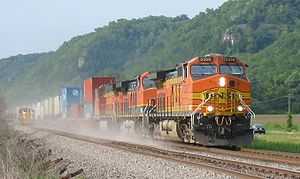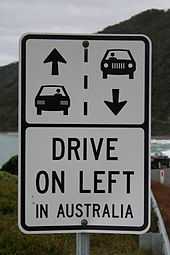Bidirectional traffic
In transportation infrastructure, a bidirectional traffic system divides travelers into two streams of traffic that flow in opposite directions.[1]
Bidirectional traffic is observed in a wide variety of applications, including aerodynamics; architecture; cellular automata; data; engineering; entomology; model theory; molecular biology; ornithology; pedestrian movement; and statistical mechanics.
Aerodynamics
In the design and construction of tunnels, bidirectional traffic can markedly affect ventilation considerations.[2][3][4]
Modelling
Microscopic traffic flow models have been proposed for bidirectional automobile, pedestrian, and railway traffic.[5][6][7]
Entomology
Bidirectional traffic can be observed in ant trails.[8][9] As of recent years, this behavior has been researched for insight into human traffic models.[10]
Human transportation
Airways
Aviation is normally separated by elevation, with east bound flights at odd thousand feet elevations and west bound flights at even thousand feet elevations. Above 28,000 feet only odd flight levels are used, with FL 290, 330, 370, etc., for eastbound flights and FL 310, 350, 390, etc., for westbound flights.[11] Entry to and exit from airports is always one-way traffic, as runways are chosen to allow aircraft to take off and land into the wind, to reduce ground speed.[12] Even in no wind cases, a preferred calm wind runway and direction is normally chosen and used by all flights, to avoid collisions.[13] In uncontrolled airports, airport information can be obtained from anyone at the airport. Traffic follows a specific traffic pattern, with designated entry and exits. Radio announcements are made, whether anyone is listening or not, to allow any other traffic to be aware of other traffic in the area.[14]
Railways

In the earliest days of railways in the United Kingdom, most lines were built double tracked because of the difficulty of coordinating operations in pre-telegraphy times.
Roads

Most modern roads carry bidirectional traffic, although unidirectional (one-way) streets are common in dense urban centres.
Bidirectional traffic flow is believed to influence the rate of traffic collisions. In an analysis of head-on collisions, rear-end collisions, and lane-changing collisions based on the Simon-Gutowitz bidirectional traffic model, Moussa concluded that "the risk of collisions is important when the density of cars in one lane is small and that of the other lane is high enough", and that "heavy vehicles cause an important reduction of traffic flow on the home lane and provoke an increase of the risk of car accident".[15]
In a macroscopic theory proposed by Laval, the interaction between fast and slow vehicles conforms to the Newell kinematic wave model of moving bottlenecks.[16]
Trails
Bidirectional traffic is the most common form of flow observed in trails, however, some larger pedestrian concourses exhibit multidirectional traffic.[17]
Waterways
See also
References
- ↑ Moussa, Najem (2008-11-10). "Simon–Gutowitz bidirectional traffic model revisited". Physics Letters A 372 (45): 6701–6704. arXiv:0903.1345. doi:10.1016/j.physleta.2008.08.081.
- ↑ Stephens, Herbert; D. H. Goodes (1982). "Papers presented". Fourth International Symposium on the Aerodynamics & Ventilation of Vehicle Tunnels. York, England: BHRA Fluid Engineering. pp. 466–472. ISBN 978-0-906085-63-9.
With unidirectional traffic the maximum CO concentration area can also be a high turbidity one. In the case of bidirectional traffic this should be avoided because vehicles travelling against the ventilation flow must have sufficient visibility at the tunnel entrance.
- ↑ "The aerodynamics and ventilation of vehicle tunnels: a state of the art review and bibliography". BHRA Fluid Engineering 2: 236. 1976. ISBN 978-0-900983-62-7.
- ↑ Caserta, A. S. (2000). "Principles, analysis and design". 10th International Symposium on Aerodynamics and Ventilation of Vehicle Tunnels. ISBN 978-1-86058-255-4.
- ↑ Simon, P. M.; H. A. Gutowitz (February 1998). "Cellular automaton model for bidirectional traffic". Physical Review E 57 (2): 2441–2444. arXiv:cond-mat/9801024. doi:10.1103/PhysRevE.57.2441.
- ↑ Zhang, Jin; Hui Wang; Ping Li (July 2004). "Cellular automata modeling of pedestrian’s crossing dynamics". Journal of Zhejiang University - Science A 5 (7): 835–840. doi:10.1631/jzus.2004.0835.
- ↑ Li, KePing; ZiYou Gao; Bin Ni (2005-10-10). "Cellular automaton model for railway traffic". Journal of Computational Physics 209 (1): 179–192. doi:10.1016/j.jcp.2005.03.016.
Similar CA models include the bidirectional traffic model and the traffic networks model, etc.
- ↑ Burd, Martin; N. Aranwela (February 2003). "Head-on encounter rates and walking speed of foragers in leaf-cutting ant traffic" (PDF). Insectes Sociaux (Birkhäuser Basel) 50 (1): 3–8. doi:10.1007/s000400300001. Retrieved 2009-09-10.
- ↑ Ribeiro, Pedro; André Frazão Helene; Gilberto Xavier; Carlos Navas; Fernando Leite Ribeiro (2009-04-01). Dornhaus, Anna, ed. "Ants can learn to forage on one-way trails". PLoS ONE 4 (4): e5024. doi:10.1371/journal.pone.0005024. PMC 2659768. PMID 19337369. Retrieved 2009-09-10.
- ↑ John, Alexander; Andreas Schadschneider; Debashish Chowdhury; Katsuhiro Nishinari (March 2008). "Characteristics of ant-inspired traffic flow". Swarm Intelligence (Springer New York) 2 (1): 25–41. doi:10.1007/s11721-008-0010-8.
- ↑ airways and aircraft separation
- ↑ Relative Velocity
- ↑ Calm Wind Runways
- ↑ Operations at nontowered airports
- ↑ Moussa, Najem (2009). "Simulation study of traffic accidents in bidirectional traffic models". arXiv:0905.4252 [physics.soc-ph].
- ↑ Laval, Jorge (December 2006). "A macroscopic theory of two-lane rural roads" (PDF). Transportation Research Part B: Methodological 40 (10): 937–944. doi:10.1016/j.trb.2006.03.002. Retrieved 2009-09-10.
- ↑ Blue, Victor; Jeffrey Adler (1999). "Cellular automata microsimulation of bidirectional pedestrian flows" (PDF). Transportation Research Record: Journal of the Transportation Research Board (Transportation Research Board of the National Academies) 1678 (1): 135–141. doi:10.3141/1678-17. Retrieved 2009-09-09.
Further reading
- "Structural design issues". Transportation research record. National Research Council, Transportation Research Board. 2000. ISBN 978-0-309-06744-7.
Two-lane rural highways with bidirectional traffic
- Michael S. Bernick; Robert Cervero (1996). Transit villages in the 21st century. McGraw-Hill. ISBN 978-0-07-005475-2.
Satellite subcenters would function as countermagnets to central Stockholm, leading to efficient bidirectional traffic flows.
- "Annual meeting". Compendium of technical papers (Institute of Transportation Engineers) 53. 1983.
Madras conducted some field studies to evolve a relationship between speed and volume of traffic on single and two lane bidirectional traffic roads.
- Bickel, John; T. R. Kuesel (1982). Tunnel engineering handbook. University of California: Van Nostrand Reinhold Company. p. 499. ISBN 978-0-442-28127-4.
This results in bidirectional traffic in a single tunnel.
- Highway Research Board; National Research Council (1972). "Proceedings of a workshop held May 17–19, 1971". Systems building for bridges. p. 46. ISBN 978-0-309-02063-3.
Obviously the hazards are far more numerous and the need for better headlighting much greater on these millions of miles of streets and highways carrying bidirectional traffic, particularly because so few of these miles have even mediocre fixed highway lighting.
- National Research Council; Transportation Research Board (1993). Pavement management systems. National Academy Press. p. 24. ISBN 978-0-309-05468-3.
- Transportation Research Board; National Research Council; Federal Transit Administration. "Report 65: "Evaluation of Bus Bulbs"" (PDF). Transit Cooperative Research Program: 20. Retrieved 2009-09-09.
Conversely, at 44 sq ft (4.1 sq m), passing slower pedestrian traffic is easier, crossing bidirectional traffic is nearly unhindered, and traveling through the zone is dramatically less affected by other walking or standing pedestrians.
- Stone, H. David (2008). Vital rails: the Charleston & Savannah Railroad and the Civil War in coastal South Carolina. University of South Carolina Press. ISBN 978-1-57003-716-0.
Single tracking and the relative lack of sidings made bidirectional traffic difficult — a difficulty that became more obvious during the conflict with the North.
- Behrens, John (1974). "A staff technical report". Recommendation for the Chicago area freight system for 1995. Chicago Area Transportation Study.
The average yard handle 350 vans of bidirectional traffic each day.
- National Research Council; Transportation Research Board (1993). "Transportation system management, parking, and travel demand management". Transportation Research Record 1404: 39. ISBN 978-0-309-05550-5.
This is especially true for physically challenged users and the elderly, who have to weave through bidirectional traffic.
- Borndörfer, Ralf; Marika Neumann; Marc E. Pfetsch (2005-11-16). "Optimal Fares for Public Transport" (PDF). In Haasis, Hans-Dietrich; Kopfer, Herbert; Schönberger, Jörn. Operations Research Proceedings 2005 2005. Bremen: Springer Berlin Heidelberg. doi:10.1007/3-540-32539-5. Retrieved 2009-09-09.
It consists of a network containing 23 nodes (stations) and a corresponding upper-triangular origin-destination matrix (d0st) with 210 nonzero entries that account for a symmetric bidirectional traffic.
- Burger, H. (1993). "Options for tunnelling". Developments in Geotechnical Engineering: 35. ISBN 978-0-444-89935-4.
A tunnel with an inner diameter of 9.75 meters allowing a bidirectional traffic of 2 x 3 car lanes on two superimposed levels.
- Cervero, Robert (1998). The transit metropolis: a global inquiry. Island Press. p. 77. ISBN 978-1-55963-591-2.
As shown in Stockholm and Curitiba, mixed land uses can translate into balanced, bidirectional traffic flows.
- "Volume 26, Issues 1-7". Electronic design (Hayden Pub. Co). 1978.
But to get the sign's X-band Doppler radar to work reliably from overpasses (see photo) or from overhead sign posts, two major problems had to be overcome: fluctuations in the Doppler returns because of multipath cancellations from cars approaching the sign, and interference caused by bidirectional traffic flow.
- Tang, T.Q.; Huang, H.J.; Wong, S.C.; Xu, X.Y. (2007-03-15). "A new overtaking model and numerical tests". Physica A: Statistical Mechanics and its Applications 376: 649–657. doi:10.1016/j.physa.2006.10.044.
The overtaking in a two-lane bidirectional traffic flow is also analyzed.
- Bényei, András; Péter Golarits (2002). "Measurements to define relationship between traffic volume and traffic conditions in Hungary" (PDF). Periodica Polytechnica Ser. Civ. Eng. 46 (1): 83–94. Retrieved 2009-09-09.
In Fig. 3 the s = f (V∗) functions are presented, showing the V∗ PCU/h fictive bidirectional traffic volumes delimiting the proposed three grades of level of services.
- Hamza-lup, Georgiana; Kien A. Hua; Minh Le; Rui Peng (2004). "Enhancing intelligent transportation systems to improve and support homeland security" (PDF). IEEE Intelligent Transportation Systems Conference. Washington, D.C. p. 250. doi:10.1109/ITSC.2004.1398906. Retrieved 2009-09-09.
In the Fastest-Links approach, links that are not on the multicast tree are allowed to have bidirectional traffic, so we only need to enforce certain directions for the traffic flowing through the intersections/nodes in the multicast tree.
- US 5815161 "As shown, the two links 100, 102 have mutually opposite traffic directions. This means that in the joining, the complex road junction can get a bidirectional traffic indication."
- Sato, Yoshimichi; Koji Makanae (December 2006). "Development and Evaluation of In-vehicle Signing System Utilizing RFID tags as Digital Traffic Signs" (PDF). International Journal of ITS Research 40 (1). Retrieved 2009-09-09.
This approach makes the system applicable also to a narrow undivided road carrying bidirectional traffic
- Blue, Victor; Jeffrey Adler (2000). "Cellular automata model of emergent collective bi-directional pedestrian dynamics" (PDF). In M.A. Bedau, J.S. McCaskill, N.H. Packard, S. Rasmussen. Artificial Life VII: Proceedings of the Seventh International Conference on Artificial Life, eds. Portland, Oregon: The MIT Press. pp. 437–445. ISBN 978-0-262-52290-8. Retrieved 2009-09-09.
The bi-directional vehicular flow model focuses on modeling acceleration and passing movements within the framework of two lanes of opposing flow.
- "Road Watch: The Budapest Sun traffic buster". The Budapest Sun. 2008-05-07. Retrieved 2009-09-09.
The bidirectional traffic flow is controlled by traffic lights.
- Christmann, Samantha (2009-08-10). "Traffic brings new life to Main Street". The Buffalo News. Retrieved 2009-09-09.
A month after the 700 block of Main Street opened to bidirectional traffic, business owners said they are seeing an improvement -- no two ways about it.
- Dorna, B.; M. Kramar Fijavžb; R. Nagela; A. Radla (2009-06-21). "The semigroup approach to transport processes in networks" (PDF). Physica D: Nonlinear Phenomena 239 (15): 1416. doi:10.1016/j.physd.2009.06.012. Retrieved 2009-09-10.
| ||||||||||||||||||||||||||||||||||||||||||